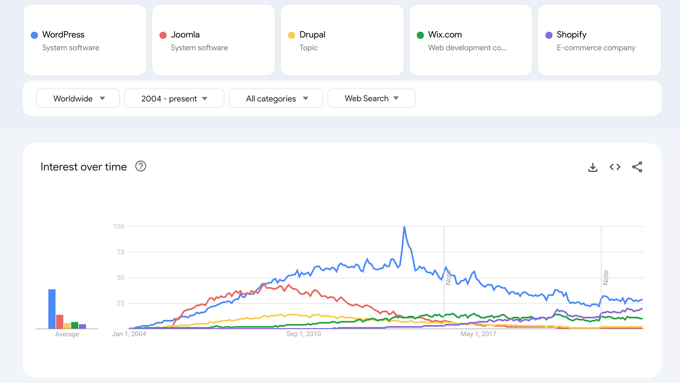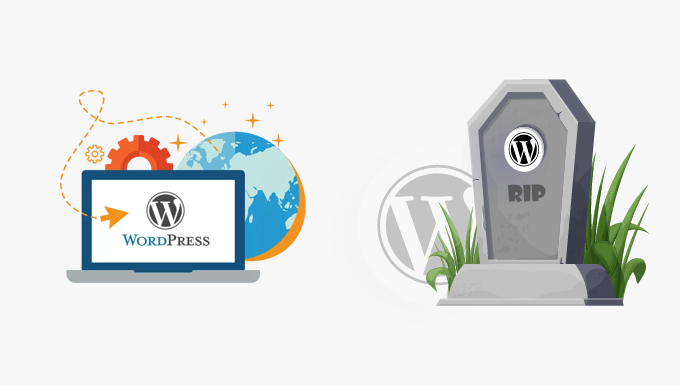Have you come across allegations and speculations suggesting that WordPress is on the decline or poised to be supplanted by emerging website builders or software platforms?
You might find yourself questioning the validity of these rumors and pondering whether it’s worthwhile to continue using WordPress.
Within this blog post, we aim to scrutinize the current status of WordPress to debunk any unfounded claims of its demise.
What’s the Basis for the WordPress Decline Rumors?
Certain individuals are propagating rumors with the intent of dissuading you from opting for a WordPress website. These rumors may be disseminated through platforms like Twitter or Reddit, and some may even dedicate entire blog entries to this narrative of WordPress’s decline.
The motives behind these assertions are not always clear. It’s possible that witnessing WordPress’s immense success has sparked doubts about its sustainability. Alternatively, those expressing such views might be fervent advocates of an alternative to WordPress, convinced that it’s on the cusp of dominating the market.
Regardless of their motivations, a thorough examination of the available evidence reveals that these claims are unsubstantiated. There is absolutely no concrete evidence suggesting that WordPress is in decline or that its dedicated user base is preparing to abandon it.
With that said, let’s meticulously delve into the current state of WordPress to ascertain whether there are any valid reasons to entertain the notion of its decline. You can swiftly navigate to specific sections of our discourse using the provided quick links:
- WordPress’s Standing in Google Trends
- WordPress’s Market Share
- The Present State of WordPress Security
- The Landscape of WordPress Updates
- The Outlook for WordPress Plugins
- The Trends in WordPress Themes
- The Vibrancy of the WordPress Economy
WordPress’s Standing in Google Trends
Our analysis commences with an exploration of the search volume surrounding WordPress. This point of origin is chosen due to the common employment of these statistics to argue that the allure of WordPress is waning.
Displayed below is a Google Trends graph illustrating the ebb and flow of search interest in WordPress from 2004 onward.

The graph vividly portrays a remarkable surge in search interest concerning WordPress approximately in 2014. Nevertheless, it’s worth highlighting that considerable curiosity for WordPress endures even in the present times.
Yet, the graph alone doesn’t convey this notion with clarity. To provide a more comprehensive perspective, we’ve juxtaposed the same graph with prominent alternatives to WordPress.

This comparison readily illustrates that the level of search interest directed towards WordPress surpasses that of any other content management system (CMS).
Recent trends disclose an uptick in searches for alternatives such as Wix and Shopify. These platforms might be particularly appealing to novices due to their ease of initiation.
However, as time progresses, a significant number of users encounter dissatisfaction stemming from the constraints on customization or the inability to host their websites on independent servers. For a deeper exploration of this, consult our comprehensive analyses contrasting Wix and WordPress, as well as Shopify and WooCommerce.
WordPress’s Market Share
Having explored search volume, you may now be inquisitive about the actual prevalence of WordPress across websites and how it compares with alternative web platforms.
In succinct terms, WordPress unequivocally stands as the market leader, with no competitor even approaching its status.
Presently, an astonishing 43% of all websites opt for WordPress as their chosen content management system. This translates to a staggering 810 million websites globally. Furthermore, WordPress commands a substantial 65% share of the worldwide CMS market.
Moreover, WordPress finds favor even among the most eminent enterprises. A notable 38% of the top 10,000 websites harness the power of WordPress. Esteemed brands like Disney, Sony, Facebook, and others rely on WordPress to drive their online presence.
To provide a visual depiction of WordPress’s commanding market share, consider this graph from Colorlib.

The graph illuminates a decline in websites without a content management system (indicated by the green line). Conversely, the adoption of WordPress (highlighted by the red line) exhibits a consistent growth trajectory, while alternative content management systems scarcely register on the graph.
For instance, Shopify ranks as the second most favored choice, yet its influence extends to merely around 4.4% of all websites. In contrast, despite substantial marketing efforts, Wix’s reach encompasses a mere 1.9% of websites.
The vigor and vitality of WordPress are unmistakable, rendering it implausible that the vast array of website proprietors, comprising over 43%, would abruptly reconsider their allegiance to WordPress.
The Present State of WordPress Security
Given its substantial market presence, WordPress inevitably draws the attention of hackers aiming for unauthorized access, distributed denial-of-service (DDoS) attacks, and the dissemination of malicious software like malware and trojans.
Reassuringly, WordPress’s core undergoes stringent security evaluations, rendering it more resilient than numerous other platforms.
However, it’s imperative not to become complacent about website security. Data from Sucuri, a prominent website security company, reveals that approximately 97% of WordPress website breaches transpire when owners neglect to adhere to secure security practices:
- An overwhelming 39% of compromised WordPress websites were employing outdated software versions. This underscores the importance of consistently utilizing the most recent iteration of WordPress on your website.
- Nearly 50% of security vulnerabilities afflicting WordPress sites stem from obsolete or inadequately-coded plugins or themes.
- Approximately 8% of WordPress site breaches can be attributed to weak passwords.
To bolster your WordPress site’s security, adopting fundamental security best practices is crucial. For a comprehensive guide on fortifying your WordPress security, replete with step-by-step instructions, consult our detailed WordPress security manual.
The Landscape of WordPress Updates
Despite its inception in 2004, WordPress maintains a dynamic evolution through frequent updates that introduce novel functionalities and ensure the user interface remains contemporary.
Being an open-source endeavor propelled by a global community of users, WordPress thrives on the diverse contributions from various quarters:
- The WordPress translation community has rendered the CMS fully accessible in over 50 languages and partially localized it in excess of 200.
- Worldwide WordPress communities orchestrate numerous WordCamps annually, alongside an array of meetups spanning diverse countries.
- Flourishing within the realm of Facebook, numerous WordPress groups thrive, with the WPBeginner Engage group being the most extensive, boasting a membership exceeding 95,000.
The development team consistently releases updates multiple times a year, exemplified by WordPress 6.3, which made its debut in August 2023. These updates encompass rectifications of bugs, enhancements to security, and the introduction of novel features.
Past instances of noteworthy WordPress updates include the advent of the Gutenberg editor, a tool facilitating the seamless inclusion of diverse elements into blog posts through a block-based approach. Akin in functionality, the full site editor empowers users to customize themes with equal ease. Moreover, the command palette tool enhances productivity by enabling swift execution of tasks via keyboard shortcuts.
Each year, the platform not only amplifies its capabilities but also enhances its user-friendliness. A perusal of our article on the evolution of the WordPress user interface attests to the contemporary nature of the latest interface.
Beyond the advancements inherent in WordPress updates, the platform’s extensibility remains a hallmark, with the capability to augment functionalities through plugins.
The Outlook for WordPress Plugins
Undoubtedly, the key impetus propelling WordPress’s widespread acclaim is its expansive ecosystem of plugins. In this realm, no other web platform comes close in terms of variety and abundance.
Functioning akin to applications for your WordPress site, plugins introduce new attributes and augment its capabilities. For a comprehensive grasp, delve into our guide elucidating WordPress plugins and their operational mechanics.
Remarkably, the WordPress.org Plugin Directory alone boasts a staggering array of over 60,000 free plugins. Presently, the top 61 WordPress plugins have found a home on over 1 million websites, with a remarkable 9 of these plugins gracing over 5 million websites.

Benefitting from this robust plugin landscape, you can enrich your website with tailored functionalities without incurring the exorbitant expenses of bespoke development.
The repository of free WordPress plugins encompasses an impressive array catering to virtually every conceivable facet of website functionality. This spans from integrating contact forms and facilitating membership sales to constructing captivating landing pages and optimizing SEO performance.
Irrespective of the feature you aspire to integrate into your WordPress site, you can rest assured that a plugin exists to fulfill your requirement.
The Trends in WordPress Themes
In the realm of WordPress, themes wield the power to shape a website’s visual identity. These WordPress-specific design templates can be seamlessly installed on your website, orchestrating a transformative shift in its aesthetic essence.
The panorama of WordPress themes presents a lavish diversity. Within this landscape, a multitude of both free and premium themes abound, furnishing WordPress users with an unending array of design choices, layout options, color palettes, and functional attributes.
The treasure trove of free WordPress themes extends to more than 10,000 offerings within WordPress.org’s repository of free themes alone.
Furthermore, a host of superlative premium themes, exemplified by Divi and Astra, emerge as prime selections. In fact, platforms like SeedProd even empower you to construct a tailor-made custom theme. This degree of customization is unparalleled within the realm of other content management systems (CMS).
In essence, the realm of WordPress themes unveils a realm of possibilities, enabling you to sculpt your website’s visual identity to perfection.
The Vibrancy of the WordPress Economy
Despite WordPress’s open-source nature, its influence extends far beyond as it fosters a dynamic ecosystem that spans several billion dollars, giving rise to myriad employment opportunities worldwide. This thriving environment encompasses freelancers, developers, and enterprises specializing in vending WordPress-linked products and services.
Across esteemed freelancing platforms and job boards, numerous postings beckon for WordPress expertise, reflecting a demand for talents in this domain. The compensation for WordPress developers varies, ranging from $20 to $100 per hour, contingent on their proficiency and the complexity of the task.
Within this ecosystem, a plethora of businesses, both small and large, along with agencies and individual developers, thrive by proffering WordPress-centric products and services. To gain a better understanding, explore our roster highlighting influential WordPress enterprises and their endeavors.
These entities exhibit a substantial investment in WordPress and wield a profound influence in fortifying its ascendancy. Their collective dedication is a driving force behind WordPress’s enduring triumph.
Conclusion
In conclusion, the dynamic landscape of WordPress is a testament to its unwavering relevance and vitality. Dispelling rumors of decline, WordPress stands as a powerhouse in the digital realm. Its search volume and dominance, spanning over 810 million websites, reaffirm its position as an unrivaled choice.
Security remains a priority, with the WordPress community ardently safeguarding its core against threats. As the software evolves through regular updates, its resilience grows, making it a secure choice for countless users.
The treasure trove of plugins beckons innovation, facilitating tailored enhancements without the need for intricate development. Themes, the aesthetic backbone, unleash an imaginative playground of design possibilities, enabling you to craft a virtual canvas to your heart’s desire.
The WordPress economy, far-reaching and bustling, employs a diverse spectrum of talents globally. From freelancers to developers and enterprises, it underpins a thriving ecosystem, forging a symbiotic relationship that enriches both WordPress and its stakeholders.
In summation, WordPress’s journey is one of enduring excellence. From its formidable market share to its impregnable security measures, limitless customization avenues, and thriving economy, WordPress’s influence resounds across websites and industries. It is not merely a platform; it’s a testament to the boundless potential of digital creation and innovation.








